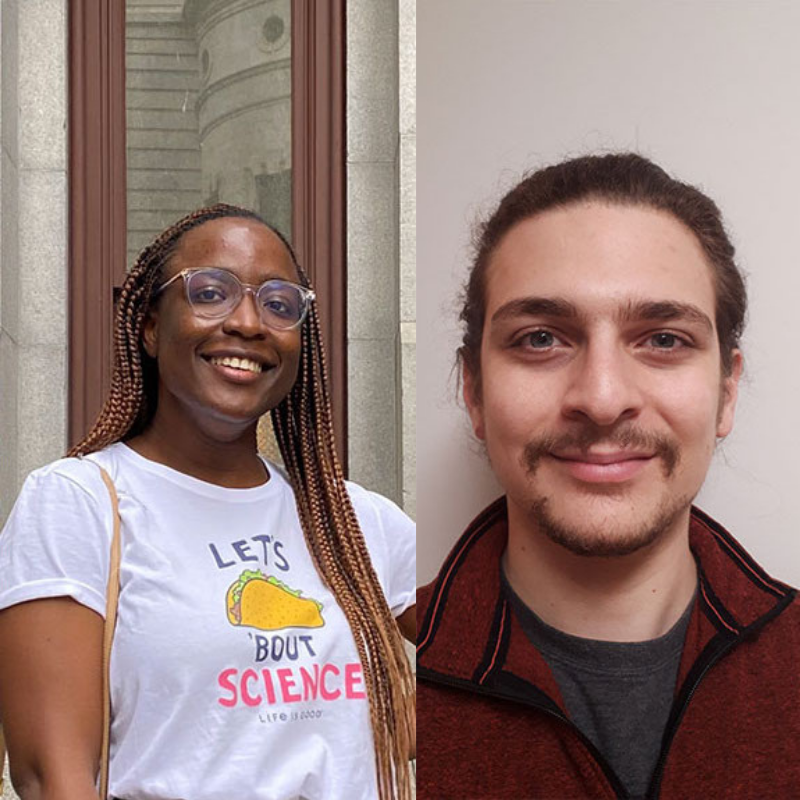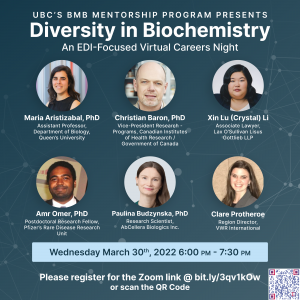Winners of the 2022 3MT competition

Ten graduate students competed in the Three Minute Thesis (3MT) final on March 30th to find out who could best summarize and present years of research in only three minutes.
Our graduate students, Mopelola Akinlaja (Foster Lab) and Nicolas Pereyra (Devine Lab) was selected as the finalists and one of the four winners.
Second place
- Mopelola Akinlaja, PhD in Biochemistry and Molecular Biology, A peek into the honey bee gut: Understanding Nosema infection in honey bees. Supervisor
Third Place
- Nicolas Pereyra, MSc in Biochemistry and Molecular Biology, Modified platelet storage devices to improve quality during storage. Supervisor: Dr. Dana Devine
Congratulations to Lola, Nicolas and all the finalists and participants!
- Learn more about the 2022 3MT competition and results
- Learn more about Mopelola Akinlaja
BMBDG Seminar: Ph.D. Exit Seminar – James Li

Title: Heterologous production and functional characterization of Auxiliary Activity family 10 lytic polysaccharide monooxygenases for fiber functionalization
Abstract: “Organic matter from plants and animals (biomass) represents a largely untapped renewable resource. Cellulose and chitin are carbohydrate polymers that account for the majority of biomass found on earth and can be used to produce fuels, chemicals, and bio-based materials. The primary barrier prohibiting efficient utilization of these materials for industrial applications (valorization) is their difficulty to break down (recalcitrance), which stems from their high chemical stability. Detritus-consuming organisms (saprotrophs) such as bacteria and fungi secrete powerful oxidative enzymes called lytic polysaccharide monooxygenases (LPMOs) that depolymerize recalcitrant cellulose and chitin fibers. This thesis explores the potential of a canonical family of bacterial LPMOs to aid in the valorization of biomass polysaccharides through exploration of heterologous protein production strategies, biochemical characterization studies, and a proof-of-concept scheme to utilize LPMOs for chemo-enzymatic modification of cellulose fibers.”
Monday, April 04, 2022 at 2:30 pm via Zoom
Hosted by: Harry Brumer
BMBDG Seminar: PhD Exit Seminar – James Li

Title: Heterologous production and functional characterization of Auxiliary Activity family 10 lytic polysaccharide monooxygenases for fiber functionalization
“Organic matter from plants and animals (biomass) represents a largely untapped renewable resource. Cellulose and chitin are carbohydrate polymers that account for the majority of biomass found on earth and can be used to produce fuels, chemicals, and bio-based materials. The primary barrier prohibiting efficient utilization of these materials for industrial applications (valorization) is their difficulty to break down (recalcitrance), which stems from their high chemical stability. Detritus-consuming organisms (saprotrophs) such as bacteria and fungi secrete powerful oxidative enzymes called lytic polysaccharide monooxygenases (LPMOs) that depolymerize recalcitrant cellulose and chitin fibers. This thesis explores the potential of a canonical family of bacterial LPMOs to aid in the valorization of biomass polysaccharides through exploration of heterologous protein production strategies, biochemical characterization studies, and a proof-of-concept scheme to utilize LPMOs for chemo-enzymatic modification of cellulose fibers.”
Monday, April 04, 2022 at 2:30 pm via Zoom
Hosted by: Harry Brumer
BMBDG Seminar: PhD Exit Seminar – David Rattray

Title: Proteomic Method Development for Studying Salmonella-Host Protein Interactions.
Salmonella is a pathogen of humans and animals. Pathogenesis is mediated by effector proteins that are translocated into host cells. These effector proteins interact with host proteins and cellular processes to establish a replication permissive niche for the bacterium. Efforts to determine the roles of the effector proteins have revealed many insights, however the understanding of the interaction between host and pathogen is incomplete. To further investigate the impact of Salmonella effector proteins on host cells, we developed high throughput proteomic methods to assess changes that occur during infection.
Monday, March 28, 2022 at 2:30 pm via Zoom.
Hosted by: Dr. Leonard Foster
Diana Vasyliuk Defended MSc Thesis

Congratulations Diana! On February 25, 2022. Diana Vasyliuk successfully defended her thesis, “Structural characterization of the yeast SAGA complex”. Diana is a trainee in Dr. CalvinYip’s Lab.
2021-2022 Undergraduate 3MT Competition Winner – Alandra Mendez!

Alandra Mendez, a Biochemistry & Molecular Biology undergraduate student, won UBC’s annual Undergraduate 3 Three Minute Thesis (3MT) competition on Saturday March 5th. Congratulations!
The title of Alandra’s thesis is “Isolating the Interactome: Dounce vs. Freeze-Thaw”.
The UBC Undergraduate 3MT competition is a UBC wide competition open to any undergraduates engaged in UBC research projects and is funded through a UBC PURE award.
This event will provide undergraduate students with the opportunity to submit a recorded 3 Minute Thesis (3MT) of their directed studies or honours thesis. Students have a static powerpoint slide and must give a 3 minute oration of their research background and findings in the context of a general audience.
For the initial submissions, all applicants will receive feedback from a panel of UBC faculty adjudicators outside of their field of study on their submitted 3MT, which will be useful for future oral presentations and a unique challenge to get students thinking about what relevance their research has as they begin to conduct their studies.
A group of the most outstanding applicants will then be selected by the adjudication committee to compete for cash prizes in the live competition.
BMB Diversity in Biochemistry: An EDI-Focused Virtual Careers Night
In an effort to promote equity, diversity, and inclusivity (EDI) in the department of Biochemistry and Molecular Biology (BMB) at UBC, the BMB EDI committee is holding it’s first EDI-focused career’s night featuring speakers from a diverse range of backgrounds who will share their experiences regarding their educational and career trajectories.
The event is on March 30, from 6:00 – 7:30 pm PDT via Zoom and will be split into 2 sections. The first section will feature a panel-style Q&A session; the latter will have speakers split into breakout rooms, where students can drop by to ask specific questions of interest.
Please register for the event here.
